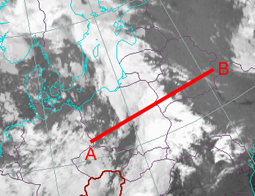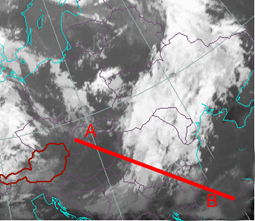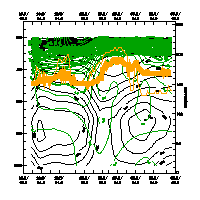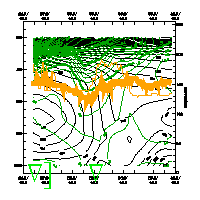Vertical Cross Sections
Vertical cross sections are important tools as they allow a view into the vertical extension of synoptic and mesoscale systems. In this chapter two aspects are of interest which will be discussed:- The physical state of the frontal systems in the vertical dimension in the area of the wave
- The topic of the downward protrusion of stratospheric air.
Vertical Cross Sections (VCS) for the frontal system of the two waves A and B
In the next chapter several numerical parameters in the vertical cross sections are discussed for both waves and similarities and differences are investigated.

|
Wave A: 2nd July 2004: 12UTC |

|
Wave B: 3rd July 2004: 18UTC |
Vertical Cross Sections (VCS) for a sequence of PV
In the next chapter a sequence of Vertical Cross Sections is presented which shows the downward protrusion of PV = 1 and/or 2 units. This is a sign characterising the interaction between high and low levels and the increase of cyclogenesis.

|
Sequence of PV for Wave A: 2nd July 2004:00 UTC - 3rd July 2004:00UTC |

|
Sequence of PV for Wave B: 3rd July 2004:00 UTC - 4th July 2004:00UTC |
Summary of the investigations in this chapter
The vertical cross section reveals for both cases very unstable frontal surfaces which are steeply downward inclined and show bulges in the lowest layers. There are differences between the two case studies but generally spoken one can say that the frontal surfaces show maxima of convergence with upward motion on top, cyclonic vorticity behind and PVA in top of the cloud bands. Both case studies show a low tropopause immediately south of the wave bulge but while for the first case (wave A) PV = 1 unit does not protrude further down, is such a process clearly seen in the second wave with PV = 1 values reaching in form of a tongue to 500 hPa. Such situation is well known from cases of rapid cyclogenesis and is typical for the mutual enhancement of cyclogensis from above and from below.